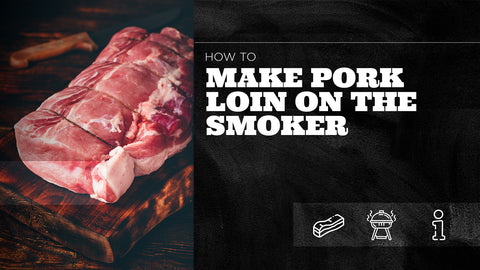Pork loin is a fantastic cut of meat for cooking on the smoker. It is a large cut that lets you serve lots of people and the lean cut of meat is an ideal canvas for getting creative with flavors. Most importantly, the loin is affordable and cooks quickly so it is a great choice for almost any meal.
Picking a good quality pork loin roast is the first step to delivering a delicious meal, followed by making smart flavor choices and using the right process to cook a pork loin to perfection. Smoking a pork loin locks in juiciness and provides a depth of flavor and texture that makes this cut one of our favorites any time of the year.
What is a Pork Loin Roast?
Let's start by clearing up one of the more confusing parts of smoking a pork loin. There are two cuts – a pork loin and pork tenderloin – which sound similar but are not the same. The pork tenderloin is a long, narrow cut that comes from the inside of the ribs. This cut is always boneless and is often used to make chops and steaks.
The pork loin roast comes from the back of the pig from the shoulders to the rump. It is larger, generally square cut, and is available bone-in or boneless. When the bone is included, it is typically a portion of the shoulder blade bone you'll find. Many butchers remove the bone to provide a cleaner finished product.
The pork loin will have a thin fat cap on the top and will be light pink in color. This is one of the ways you can tell a loin from a pork tenderloin, as the former is darker red and has more marbling of fat than the lean loin cut.
Smoked Pork Loin
Once you have selected a pork loin roast, you will need to prepare it so that it is tender and delicious when smoked. You'll notice that the loin has a fat cap on the top. Do not cut the pork loin fat cap off. The loin is a lean cut that does not have very much intermuscular fat, so you want to keep as much fat as possible.
Brining
A pork loin is a good candidate for brining because of the leanness of the meat. Brining helps to lock in moisture to prevent the roast from drying out while it cooks. You can use any popular brine recipe for a pork loin. We often use an apple cider vinegar brine and add fresh herbs like rosemary and sage along with bay leaf.
Start by heating enough water to fully immerse the loin. Add one cup of salt for every gallon of hot water and stir to dissolve the salt. Add the herbs to the hot water and allow them to simmer for a few minutes. This step helps to extract the oils from the herbs that give your recipe the flavor. After a few minutes, remove the brine from the heat and add one cup of apple cider vinegar per gallon of water. Allow the brine to cool to room temperature. The salt and vinegar act as preservatives to reduce the chance of bacterial growth.
Once the brine is cooled, place the pork loin in a bowl, tray, or plastic bag and cover it completely with the brine mixture. Use a plate if necessary to hold the meat below the surface. Brine for three to 12 hours keeping in mind that the longer the meat is in the brine, the saltier it will become. We usually will brine ours for four to six hours and we have great results this way.
Remove the pork loin from the brine and pat dry. Do not rinse the pork loin off! This is a big food safety mistake and at best simply washes flavor off of the meat.
The final step to get your pork loin ready for smoking is to use a dry rub. Keep in mind that the brine has made the loin salty, so you want to reduce the amount of salt in your typical dry rub. Any combination of flavors works great. We will sometimes use a lemon and citrus rub with black and white pepper, or we will go traditional and use lots of garlic powder, onion powder, and black pepper to compliment our favorite BBQ sauce.
Our Bearded Butcher Blend Seasonings are a great way to add lots of flavor and the wide variety of blends we have created give you plenty of opportunity to create unique flavor combinations. One of our favorite options is using the Hollywood or the Black blend. These two offer the right combination of sweetness and saltiness to perfectly enhance the rather bland flavor of pork loin.
Sprinkle the dry rub all over the meat and rub it into the meat making sure the pork loin is completely covered in the rub. It does not need to sit for any length of time so you can apply the dry rub while the smoker is coming up to temperature. Let the loin rest on the counter to begin warming up, but don't let it sit so long that it is unsafe.
How to Smoke A Pork Loin
Setting up your smoker for a pork loin is rather easy. This lean cut cooks at a low temperature and doesn't take very long, so you won't need a ton of pellets or lump charcoal to get great results.
Start your smoker and set the temperature to 225 degrees for a pellet smoker and about 250 degrees for a charcoal smoker. Once the smoker temperature is stable and the smoke output is clean, place the pork loin fat cap side up on the grill grate.
Adjust your charcoal smoker so that it maintains 225 degrees. Pellet smokers will automatically correct for the temperature change when the loin is put in the smoker.
Length of Time for Smoking Pork Loin
The average pork loin will require between two-and-a-half and three hours in the smoker at 225 degrees. Use a meat thermometer to check the thickest part of the roast. You want to cook the pork loin roast to an internal temperature of 145 degrees at a minimum. We don't recommend cooking pork loin above 150 degrees because it is a lean cut that can easily dry out and get very tough.
Hardwood Choices for Smoking Pork Loin
Just about any hardwood pellet or wood chips work great for pork loin. Our favorite lately has been applewood. This fruitwood offers a slightly sweet and smoky flavor that compliments most dry rub recipes. Hickory is another popular choice that is reminiscent of the flavor of bacon.
Oak and pecan are awesome choices for a pork loin that both offer a mild flavor perfect for spicy dry rubs. Mesquite can be a good choice when you are looking for a distinctly smoky flavorful crust.
Smoked Pork Loin Recipe
Ingredients:
4-6 lb Pork loin, untrimmed bone-in or boneless
For the Brine:
- 1 gallon cold water
- 1 cup kosher salt
- 1 cup apple cider vinegar
- Fresh herbs of your choice (rosemary, thyme, oregano, bay leaf, lavender, and marjoram make good choices)
For the Dry Rub:
- Crushed herbs and spices (Black and white pepper, garlic powder, onion powder)
- Bearded Butcher Blend Seasoning of choice
Instructions:
- Heat water for the brine to a simmer and add herbs and salt. Stir to dissolve the salt and remove from heat.
- Add apple cider vinegar and allow the brine to cool to room temperature. Add brine to the pork loin in a sealable pan or a plastic bag so the pork loin is completely under the liquid. Brine the roast for four to 12 hours.
- Drain the brine from the roast and pat dry. Do not rinse the loin.
- Mix the ingredients for the dry rub in a small bowl then sprinkle the rub over the meat. Pat the rub onto the meat so that every part of the roast is covered.
- Preheat the smoker to 225-250 degrees. Place the pork loin on the grill grates and smoke the roast for 2.5 to 3 hours until a meat thermometer inserted into the thickest part of the loin registers 145 degrees minimum. Do not overcook.
- Remove the loin from the smoker and place on a cutting board. Allow the roast to rest for 30 minutes before slicing. Slice across the thinnest direction in quarter-inch slices so that the meat is cut against the grain. Serve hot.
Smoking a pork loin is one of the easier recipes out there and gets consistently good results. Pork loin has very little flavor on its own, so use big, bold flavors to get the most from a pork loin. This is a good cut for getting creative by adding things like tequila to the brine or using uncommon hardwood choices like mesquite.
The large size and quick cooking time of pork loin make it a good choice for serving a big crowd. It is an affordable and lean cut that pairs well with mashed potatoes, buttery biscuits, and roasted vegetables.



